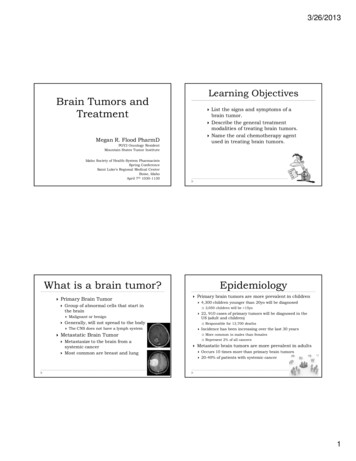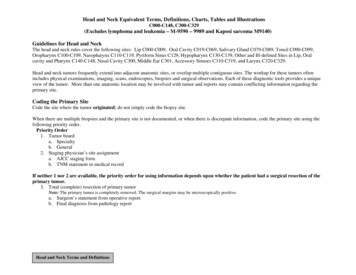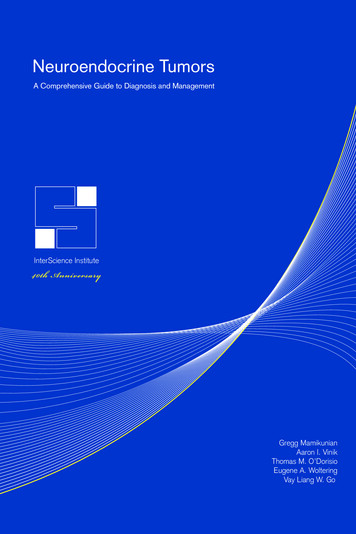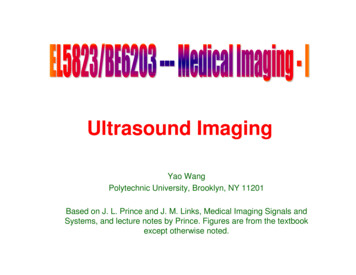
Transcription
3/26/2013Learning ObjectivesBrain Tumors andTreatment Megan R. Flood PharmDPGY2 Oncology ResidentMountain States Tumor InstituteList the signs and symptoms of abrain tumor.Describe the general treatmentmodalities of treating brain tumors.Name the oral chemotherapy agentused in treating brain tumors.Idaho Society of Health-System PharmacistsSpring ConferenceSaint Luke’s Regional Medical CenterBoise, IdahoApril 7th 1030-1130What is a brain tumor? Primary Brain Tumor Primary brain tumors are more prevalent in children 4,300 children younger than 20yo will be diagnosed 22, 910 cases of primary tumors will be diagnosed in theUS (adult and children) Incidence has been increasing over the last 30 years Malignant or benignGenerally, will not spread to the body Group of abnormal cells that start inthe brain Epidemiology The CNS does not have a lymph systemMetastatic Brain Tumor Metastasize to the brain from asystemic cancerMost common are breast and lung 3,050 children will be 15yoResponsible for 13,700 deaths More common in males than females Represent 2% of all cancersMetastatic brain tumors are more prevalent in adults Occurs 10 times more than primary brain tumors20-40% of patients with systemic cancer1
3/26/2013Type of Brain Tumor Type of Brain TumorThere are more than 120 types of tumors in the brainand central nervous systemThe type of tumor depends on the type of tissue andwhere the abnormal cells began to growBenignMalignantMeningiomasSchwannomaPituitary AdenomaCraniopharyngiomasAstrocytomaGlioblastoma (GBM)OligodendroglimoasPrimary CNS LymphomaIncidence RatesPathology Radiation Ionizing radiationSignificant increase in risk after irradiation as achildLatency period of 10-20 yearsGenetics 5% of primary brain tumors Li-Fraumeni Syndrome, p53 mutations, Von HippelLindau disease, Turcots SyndromeEnvironmental Exposure Oil refining, rubber manufacturing and chemists1992-19972
3/26/2013Signs and Symptoms SeizuresChanges in speech, hearingChanges in visionBalance problemsProblems with walkingProblems with memoryPersonality changesInability to concentrateWeakness in one part of the bodyNumbness or tingling in the arms,legsDiagnosis Magnetic resonance imaging (MRI)Positron-emission tomography (PET) scanStaging (WHO) Grade I: The tissue is benign. The cells look nearlylike normal brain cells, and cell growth is slow.Grade II: The tissue is malignant. The cells lookless like normal cells than do the cells in a grade Itumor.Grade III: The malignant tissue has cells that lookvery different from normal cells. The abnormal cellsare actively growing. These abnormal-appearingcells are termed anaplastic.Grade IV: The malignant tissue has cells that lookmost abnormal and tend to grow very fast.General Treatment Surgery Regardless of tumor type, remove as much aspossible, provides an accurate diagnosisRadiation therapy Standard fractionated external beam radiationtherapy Whole brain radiation Primary brain tumorsMetastatic brain tumorsChemotherapy May or may not be an optionWill need to cross the blood brain barrier3
3/26/2013Benign Primary TumorsMeningioma (WHO Grade 1) MeningiomasSchwannomaPituitary AdenomaCraniopharyngiomas Not technically a brain tumor, originate in thearachnoidSlow growingMore common in women Higher incidence in women with breast cancerTreatment Active SurveillanceSurgery Schwannoma Arises from a nerve cellMost commonly affect the 8th cranial nerve Affect people between ages of 50-60 Pituitary Adenoma Vestibulocochlear nerveInappropriate pituitary hormone secretionType of tumor depends on the cell type thetumor is derived from Treatment Active SurveillanceSurgeryStereotactic RadiationNo role for chemotherapyHigh risk of recurrenceAdjuvant radiation therapyRadiation aloneNo role for chemotherapy Proloactin (PRL)Adrenocorticotropic (ACTH)Growth Hormone (GH)ThyroidTreatment SurgeryRadiation TherapyMedical Hormone TherapyCombination4
3/26/2013Pituitary AdenomaCraniopharyngiomasTreatment by TypeSecreting Hormone1st Line2nd LineProloactin (PRL)Dopamine agnoists:cabergoline andbromocriptineSurgeryAdrenocorticotropic (ACTH)Surgery /- RadiationSteroidogenesis inhibitors:mitotane, metyrapone,ketoconazole,aminoglutethimideGrowth Hormone (GH)ThyroidNon functioning Surgery, and MedicalTherpayMedications: Dopamineanalogues (bromocriptine),Somatostatin analogues(octreotide)GH-receptor antagonist:pegvisomantSurgery /- RaditationMedical Therapy:somatostatin analogues(octreotide)Surgery Adjunctive radiationtherapy Arise from cells in the pituitary stalk andproject into the hypothalamusOccurs most commonly in children 5-14yo ,some men and women, 50-60 yoGrowth failure, sexual dysfunction and visuallossSlow growingTreatment SurgeryRadiation TherapyRadiation TherapyTranssphenoidal SurgeryCraniotomy5
3/26/2013Malignant Primary TumorsAtrocytoma AstrocytomaGlioblastoma (GBM)OligodendroglimoasPrimary CNS Lymphoma Arise from astrocytes, star shaped, supportivetissueClassified by grade – WHOSlow to fast growingMost common in the cerebral hemisphereTreatment Grade I & II – Surgery RadiationGrade III & IV – Surgery, Radiation, Chemotherapy OligodendrogliomasGlioblastoma Multiform (GBM) Most common and lethalClassified as a Grade IV astrocytomaCerebral hemisphere, brainstem and spinalchordTreatment SurgeryRadiationChemotherapy Temozolamide, carmustine, Gliadel (carmustine wafers),irinotecan, bevacizumab, thalidomaide, procarbazine,tamoxifen, cisplatin, gefitinib, erlotinibNeeds to cross the BBBProcarbazine, lomustine, vincristine, temozolamide Less aggressive, indolent, majority are lowgradeSurvival of 5 yearsArise in cerebral hemispheres, distributed inthe frontal, parietal, temporal and occipitallobesTreatment SurgeryRadiation TherapyChemotherapy Procarbazine, lomustine, vincristine6
3/26/2013Brain MetastasisPrimary CNS Lymphoma Arise from histiocytes, limited to the cranial-spinalaxisAffect immuno-compromised patients: HIV, EBV,transplantPresents around 60-70yoInfiltrate the deep structures of the brain :CSF, eyeTreatment Surgery for biopsy only Radiation therapy if 60yo Chemotherapy Good performance status, adequate renal function High dose methotrexate, vincristine, procarbazine,cytarabine Most common in adultsOccur 10x more frequently than primary brain tumorsMetastasize from the lung, melanoma and breastcancersOccur in cerebral hemispheresTreatment Surgery Whole Brain Radiation Chemotherapy Depends on the histology of the primary tumor Carmustine wafers, temozolamide, high dosemethotrexate, platinum drugs, etoposide,capecitabine, lapatinibQuestions?7
Metastatic brain tumors are more prevalent in adults Occurs 10 times more than primary brain tumors 20-40% of patients with systemic cancer. 3/26/2013 2 Type of Brain Tumor There are more than 120 types of tumors










